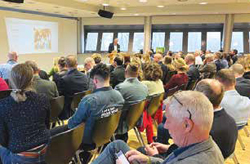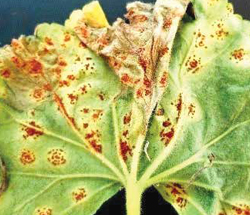Adjust the pH, the elements and the EC to avoid growth inhibition!
Do you adjust the elements in your well water and do you have a pH regulating system? With a good pH you will get a greener crop and 10-20% more growth.
Q. Which elements are useful in well/surface water?
A. These are; calcium, magnesium, sulphate and the micro elements. These elements are deducted from the feeding solution. For this reason some growers do not have to add calcium nitrate because the well water contains so much calcium.
Q Which salts are NOT useful?
A. These are sodium, chlorine and high amounts of sulphate. Above 1.5-3.0 mmol/l (40-100 ppm) growth inhibition can occur. Iron, manganese and boron can be high. Check if the amount is below the normal feeding solution concentration. High boron can cause leaf edges.

 Greenhouse engineering is an important carrier for the development of facility agriculture, as well as a “workshop” or workshop for the development of industrialization, intelligence and digitalization of agriculture. In the past 20 years, the development of greenhouse engineering from low to high level, from a single space to a comprehensive decoration, configuration, from simple to multi-functional power, from labour-intensive to machine generation, automatic control as the characteristics of technology-intensive, and so on, experienced a continuous development, continuous breakthrough, continuous improvement, keep pace with The Times, and the development of modern agriculture both adapt to each other and promote the process.
Greenhouse engineering is an important carrier for the development of facility agriculture, as well as a “workshop” or workshop for the development of industrialization, intelligence and digitalization of agriculture. In the past 20 years, the development of greenhouse engineering from low to high level, from a single space to a comprehensive decoration, configuration, from simple to multi-functional power, from labour-intensive to machine generation, automatic control as the characteristics of technology-intensive, and so on, experienced a continuous development, continuous breakthrough, continuous improvement, keep pace with The Times, and the development of modern agriculture both adapt to each other and promote the process. FSI members including flower producers, traders, and retailers gathered at IPM Essen for the General Assembly of 2023. To reflect on the Floriculture Sustainability Initiative’s 2022 achievements and actions to take towards a ‘responsible and transparent supply chain’. Besides the annual measurement of Responsibly Produced & Traded volumes, the members will start measuring and reporting on Carbon Footprinting and Living Wage. The year started off with a concrete action taken by the members: the FSI Code of Conduct was presented and adopted during the General Assembly. Members will embed this Code of Conduct in their policies and communicate it to their supply chain partners.
FSI members including flower producers, traders, and retailers gathered at IPM Essen for the General Assembly of 2023. To reflect on the Floriculture Sustainability Initiative’s 2022 achievements and actions to take towards a ‘responsible and transparent supply chain’. Besides the annual measurement of Responsibly Produced & Traded volumes, the members will start measuring and reporting on Carbon Footprinting and Living Wage. The year started off with a concrete action taken by the members: the FSI Code of Conduct was presented and adopted during the General Assembly. Members will embed this Code of Conduct in their policies and communicate it to their supply chain partners. Cut flower exporters in the country have raised concerns over increased water charges and payroll costs that have raised the cost of doing business, eroding their competitiveness.
Cut flower exporters in the country have raised concerns over increased water charges and payroll costs that have raised the cost of doing business, eroding their competitiveness. Reviewing 2022, there were several themes that emerged in the business world. This article highlights six top stories in the fresh produce sector in Kenya that made a significant impact on how the sector will perform and grow in 2023.
Reviewing 2022, there were several themes that emerged in the business world. This article highlights six top stories in the fresh produce sector in Kenya that made a significant impact on how the sector will perform and grow in 2023.
 Different issues need to be implemented and calculated. Subsequently the fertilizer tanks are calculated
Different issues need to be implemented and calculated. Subsequently the fertilizer tanks are calculated Rust diseases are common fungal infections that affect a wide range of floricultural crops, including Carnation, Roses, Chrysanthemums, Hypericums, Fuchsia, Geraniums, Gladiolus, Lilium, Marigold, Poinsettia, Snapdragons, Statice and Viola (including pansy). Rusts have the potential to negatively impact floriculture production. Rust fungi are obligate parasites, dependent upon a live host for growth and development, and seldom kill plants. However, rust infection reduces plant health and vigor, flower production, and aesthetic value.
Rust diseases are common fungal infections that affect a wide range of floricultural crops, including Carnation, Roses, Chrysanthemums, Hypericums, Fuchsia, Geraniums, Gladiolus, Lilium, Marigold, Poinsettia, Snapdragons, Statice and Viola (including pansy). Rusts have the potential to negatively impact floriculture production. Rust fungi are obligate parasites, dependent upon a live host for growth and development, and seldom kill plants. However, rust infection reduces plant health and vigor, flower production, and aesthetic value. The global economy is increasingly at a risk of sliding into recession according to recent surveys. Consumers are faced with generation-high inflation rein in spending while central banks are tightening policy aggressively. Spiralling costs of farm inputs like fertiliser in the back drop of global disruptions have also seen flower exporters grapple with higher input costs.
The global economy is increasingly at a risk of sliding into recession according to recent surveys. Consumers are faced with generation-high inflation rein in spending while central banks are tightening policy aggressively. Spiralling costs of farm inputs like fertiliser in the back drop of global disruptions have also seen flower exporters grapple with higher input costs. This year’s National Farmers’ Awards gala dinner was held in Nairobi. The event, formerly known as Presidential Farmers competition Scheme, was first launched in 2013 as a Public Private Partnership (PPP) between the Ministry of Agriculture and Elgon Kenya Limited. It was presided over by the Principal Secretary, State Department of Crop Development, Phillip Kello Harsama, on behalf of the Chief Guest, Agriculture Cabinet Secretary Mithika Linturi. Mr. Harsama was assisted by his colleague in the state department of Livestock PS Harry Kimtai and Elgon’s Managing Director Dr. Bimal Kantaria. Individual farmers as well as companies were among the awardees of the day.
This year’s National Farmers’ Awards gala dinner was held in Nairobi. The event, formerly known as Presidential Farmers competition Scheme, was first launched in 2013 as a Public Private Partnership (PPP) between the Ministry of Agriculture and Elgon Kenya Limited. It was presided over by the Principal Secretary, State Department of Crop Development, Phillip Kello Harsama, on behalf of the Chief Guest, Agriculture Cabinet Secretary Mithika Linturi. Mr. Harsama was assisted by his colleague in the state department of Livestock PS Harry Kimtai and Elgon’s Managing Director Dr. Bimal Kantaria. Individual farmers as well as companies were among the awardees of the day.